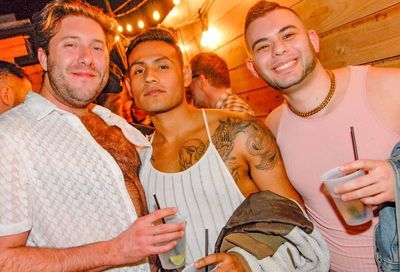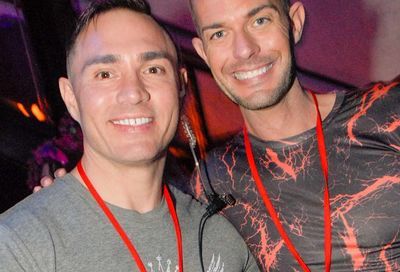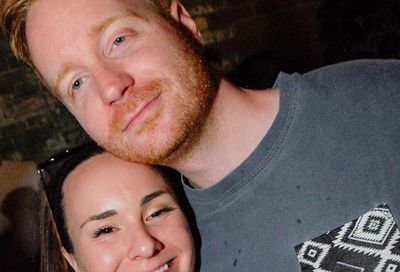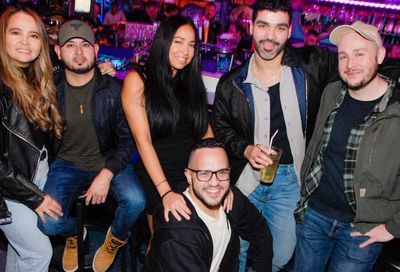The Music Man: Mark Morris on creating a legacy of indelible dance
Mark Morris won't let his dancers perform to recorded music, and his venerated company is all the more thrilling for it

Mark Morris calls himself “a musician in the guise of a choreographer.”
Morris is not just any choreographer, though. A New York Times critic has hailed him as “arguably the most successful and influential choreographer alive — and indisputably the most musical.”
So musical, in fact, Morris is the rare non-musician to be recognized with the Leonard Bernstein Lifetime Achievement Award for the Elevation of Music in Society, an honor presented by Bard College and authorized by the Bernstein estate.
Curious to know what is so elevating and indisputable about Morris when it comes to music? It’s all on full display at every performance of his venerated namesake company, which will celebrate its 40th anniversary next year.
“All of my shows, always, are with live music,” Morris says. “We don’t do another kind of performance. So that’s part of the appeal to come and see our show: I have great musicians as well as very, very great dancers.”
Live music is a rarity in the world of dance performance today, at least outside of prominent ballet companies and prestigious performing arts centers. Yet Morris’ commitment is more than just a concert extravagance, or expensive window dressing.
“When you have live music, it kind of adds lungs to the dance: It breathes more,” says Billy Smith, a member of the Mark Morris Dance Group. “It becomes more of a living thing rather than something that you’re looking at behind a frame. Usually the musicians are in the pit, close to the audience, so it’s almost like this bridge between the audience and the stage. It connects us a little more.
“There are very few choreographers who [truly] choreograph to music,” Smith continues. “Others might have music as inspiration, but they don’t really connect to it in the way that Mark does. Mark doesn’t just connect to it rhythmically — that’s a very surface way of connecting to music. He listens to the darkness and the light, and the consonance and dissonance, and the dynamic and tone of the music, and really finds a way to almost enhance it with his choreography.”
As thrilling as it is, the chance to perform to live music was not the primary reason the 33-year-old Smith signed on to be a dancer in Morris’ company a decade ago. It was the dances themselves — Morris’ rich and diverse choreography, exhibited in a strong repertory of 180 works (and counting). “Every piece that Mark makes is its own unique vision, its own world. It has its own vocabulary and language,” he says. “That’s the biggest draw for me. It’s almost like being in a company where you work for different choreographers, because every dance is so different.”
This weekend, Smith will join a dozen dancers and six musicians from the company in a showcase of all that musicality and diversity at the George Mason University Center for the Arts. The show features three relatively new, already acclaimed Morris works. Smith performs in the newest and biggest piece, set to Schubert’s Trout Quintet. When prompted, Smith declined to elaborate on the choreography, or on what viewers can expect beyond the music in the show, which also features Numerator, set to work by composer Lou Harrison, and Little Britten, set to piano etudes by Benjamin Britten.
Morris himself took a similar stance during a recent phone interview from a company stop in his hometown of Seattle. In describing the program, he keeps the focus on the music — for reasons, as it turns out, that go beyond the obvious. As Smith explains, “Mark doesn’t like to tell people what to look for, or what to experience, or what a dance is even about. He encourages everyone — and I totally agree with him — to go in with no expectation, listen to the music, watch the dance, and draw whatever conclusion you get out of it.”
For his part, Smith was roundly impressed upon his first encounter with Morris’ work a dozen years ago, during one of the company’s first of what are now regular, near-annual visits to Mason. In fact, Morris plucked Smith from the campus soon after the Fredericksburg, Virginia native graduated. “I always like coming back to Mason because I get to see all of my old teachers who helped me get to where I am now,” says Smith, who graduated in 2007. “And the program there has taken off since I left — they’ve built three beautiful new studios, they’ve gotten a lot of funding, they’ve got a lot of good talent.”
Morris couldn’t possibly disagree with that. After all, the artistic director counts two Mason alum among his company’s current ensemble, the other being Durell R. Comedy.
“The dance department at George Mason University is exemplary,” Morris says. “It’s very unusual that a university-level dance department is [so] great. They produce really wonderful dancers. There’s something going right there.”

METRO WEEKLY: Can you elaborate on what your company be performing this weekend at George Mason Center for the Arts?
MARK MORRIS: We’re doing three pieces, all quite new. The first piece is called Little Britten, and it is set to some very early piano pieces the composer Benjamin Britten had written when he was a teenage prodigy. It’s juvenilia, and people don’t know that music. They know his later work. That’s a piece for piano and three dancers.
Then there’s Numerator, which is to a piece of music by the great American composer Lou Harrison called Varied Trio, and it is for piano, violin, and percussion. And that’s in multiple movements, and it’s for six men in my company.
The last piece is a very big one — it’s for 11 dancers, and it’s to the extremely well-known piece of chamber music by Franz Schubert called the Trout Quintet. It’s a piano quintet, but instead of second violin, there’s a double bass — there’s violin, viola, cello, bass, and piano. That’s what’s unusual about it and wonderful. That’s a piece in five movements, and that is the newest one. It’s a very, very recent dance.
MW: Have you faced challenges in terms of your commitment to live musicians, in getting people to support that aspect of it?
MORRIS: You mean is it expensive? Yeah, very. Absolutely. It’d be much, much less expensive to travel with recorded music, but I won’t. I always used live musicians whenever I could, even before I could. We made the commitment to using only live music in all of our shows about 20 years ago. In fact, we bill ourselves as Mark Morris Dance Group and Music Ensemble — they’re inseparable. To keep a roster of very fine musicians, it of course means traveling with more people, and more personalities, and more hotel rooms — I wouldn’t have it any other way. The great part is that a lot of my dancers who are with me now have never danced to recorded music, which I think is great.
That also carries over to our school in Brooklyn, where every class has a musician playing — unless of course you’re doing music that requires using recorded, or produced, music. Of course there’s nothing wrong with that. But if you’re taking a class or performing with us, it’s always with live musicians.
MW: Let’s turn to how you got started. Which came first for you, dance or music?
MORRIS: Well, there was music in my house always from when I was little. My father played keyboards. My sister sang. There was always singing — just how you sing in the car, around the house. But, a lot. No one was a professional musician. So there was always music around, and I started dancing when I was probably nine. I started with Spanish dance, because I’d seen some and I loved it, and I asked for lessons. So, from the very beginning it was both of those things.
I didn’t play an instrument — I danced. I learned to read music very young. I sang in all the choirs at school. I was always singing. And then I did a lot of folk dancing — a lot of Balkan-area dancing — which required singing and dancing at the same time. So both of those things were always very important to me, but I never studied to be an instrumentalist. I’m fluent in music, and I’ve always been thrilled by it. So I would say I’m a musician in the guise of a choreographer.
MW: You grew up in a musically engaged and artistically supportive household in Seattle. Was coming out a struggle?
MORRIS: No. A lot of the time people know you’re gay before you do. My mother knew I was gay, of course. How could she not? She lived with me. So no, I came out officially at 17, but I think times have changed. It’s a different kind of stigma, or the lack thereof. I used to get credit for being gay, now it doesn’t matter anymore. I think that’s good.

MW: You used to get credit for being out?
MORRIS: Yeah. “Oh great, at least I’m special in some way.” Now it’s great because it’s not special anymore. Some of the subculture is missed, because it was kind of interesting and a secret club, but I’d rather everybody be able to do whatever the hell they want. So that battle’s mostly been won from my point of view. But I’m in my 60s, so there you go.
MW: Do you think it’s easier for people to come out these days?
MORRIS: Oh, that’s none of my business. It’s difficult for people to be curious, and aware, and serious, and interested. So whatever the hell you want to do, it’s up to you, basically. At a certain point, you have to let your parents off the hook. And there are so many varieties on all of this now, it’s dazzling. So, hooray! Everyone should just do what you want, and not expect anybody else to agree with you, and then we’d all get along fine.
MW: What motivated you to start your own company?
MORRIS: I was tired of dancing for other people. I danced with a lot of different companies and I was full of ideas. I used to irritatingly dance around the periphery of other people’s rehearsals. If somebody did that at my rehearsal, I wouldn’t like that. I was always making up dances all the time. I just didn’t have a place for them, or a company to do it in. My first shows in the early ’80s in New York and Seattle were [with] friends from class, and friends from other people’s companies. I started with people who had sort of defected from other dance companies, or worked with them simultaneously, as I did for a long time.
MW: Is there anyone in your company who has been with you from the beginning, or from near the beginning?
MORRIS: No, that’s way too long ago. I’ve had people for 20 years, but that still doesn’t get near the beginning of my company. My executive director, Nancy Umanoff, we’ve been working together for 30-plus years. So that’s the longest going back. But I’ve been around for a long time. So some of my dancers saw my work when they were adorable children, and they grew up to study me in college and then join my company — so that’s kind of interesting. That’s what happens if you stick around long enough.
MW: How has the company changed since you started?
MORRIS: People come and go over the years, and many people stay for a very long time because it’s a really good job, and there are very few dance jobs in the United States. Very, very few. So, this sort of company like mine, run by an artistic director/choreographer that only does my work, there are very few of those. One hand’s worth.
It’s a model that doesn’t really exist anymore. Most people work by engagement. They rehearse for a little while, and put on some shows, and go on tour a little bit, but it’s nearly impossible for anybody besides the big ballet industry. It’s very hard to maintain a company, and for people to live, to have a legitimate vocation of being a professional, concert-performing dancer. It’s very peripheral as far as the arts go.
MW: Why do you think it’s such a challenge to have a fully fledged, full-time dance career?
MORRIS: Part of it is the anti-art and anti-intellectual culture of a large part of this country, and the paucity of arts education in public schools. The pressure on people to conform, and to the conservatism of our country in general. I don’t want to talk about politics, because it’s suicide-provoking. But I will say that the arts in general are not valued nearly as much as they are in just about every other country in the world, including developing countries. So there’s really an embarrassment about the arts and education, and of deep thought. That’s really distressing to me.
So I do what I can. I’m not trying to teach anybody a lesson. We present these choreo-musical shows for everybody and hope they come, because it’s good stuff and you don’t see it anywhere else. We do what we can. It’s all I know, but it’s also — I’m not trying to heal the world. You can’t do that through the arts. That’s ridiculous. And it’s not necessarily therapeutic, or necessarily good for you. But it is a point of view and a way of looking at things culturally and personally that is of very, very deep importance as far as I’m concerned. And so, from a music and dance point of view, I have a big school. We do a lot of outreach, a lot of education, a lot of involvement wherever we go on tour, and in Brooklyn, where my studios are.
MW: What would you attribute to your success?
MORRIS: I think it’s because I do really, really good work. My success is that people want to see it. If nobody came to our shows, we wouldn’t exist. So it’s all dependent on everybody. I work with really great people in every category — my staff, the dancers, the musicians, and everybody who works in the organization. And, it’s now a big operation. I have a very big school in Brooklyn, and that’s running sort of independently of me and my company, although we’re in the same place, and it’s all based on my aesthetic. I mean, I’m lucky, too, but mostly it’s because we work really hard and do really good work.

MW: Is it possible for people to tour your dance center?
MORRIS: Yeah, sure. You can show up and ask to be shown around or something. I mean, most people come and take class and rehearse. [But] yes of course you can. It can be done.
MW: Do you teach?
MORRIS: I teach my company class almost exclusively. I do occasional workshops. We do sort of intensive workshops a couple of times a year, and I usually teach a couple of classes. Mostly based on music, and rhythm and composition, more than I teach technique.
I love teaching. But it’s also why my point of view, technique-wise, is part of the whole aesthetic. The other people who work with us at my school — the physical therapists, other teachers, Pilates teachers — are all based on the same, a big point of view of anatomy and musicality and the things that make dancing interesting. We’re all coming from the same direction [because] I can’t [do it all]. It’s too big for me to do it all myself, so I have a lot of dancers who are very good teachers. We have a big program for people with Parkinson’s Disease. There’s a whole lot of stuff going on, and it’s a thriving center of the community in Brooklyn, so I’m very, very proud of that.
MW: Do you do much or any dancing yourself these days?
MORRIS: Very little. I perform very rarely. Right now the program we’re doing here, I’m singing in it — I sing in one of the pieces, in the [orchestra] pit, thank God. And, I still perform in The Hard Nut, my Nutcracker, every year. I occasionally conduct a little bit, so I’m involved in that aspect of performing, but I don’t really dance that much anymore. I don’t want to.
MW: How often do you sing?
MORRIS: Just in this piece. We just put it together to do a few places, so I took it on. So that was nervous-making, but it’s fine. Once a week, my company has a choral-singing class. We learn music theory and how to sight sing, so it’s very productive for everybody, so they’re more comfortable with music.
MW: Just to be clear: Will you be singing, will that piece be performed in Virginia?
MORRIS: No. Maybe we’ve done it there — that’s possible, too. I don’t know. We have a big repertory, so we rotate stuff and keep it active and interesting.
MW: Let’s talk about your repertory and your efforts to keep your work in continuous circulation. Is that a core element to your recently announced legacy plan?
MORRIS: Yes. Dances for the Future is what we’re calling this project, which is for me to provide new work for when I can’t choreograph anymore — whether I’m dead or just can’t do it. I’ve been making up one dance or two a year that no one sees, but will be completely choreographed and designed, and lit, and finished, and then taught. Just like every other dance, dancers learn it, they pass it onto other dancers, so that it’s a living thing. And then, after I’m dead, we’ll be releasing these pieces gradually as needed, so it’s not just doing old pieces over and over again. Even though I have a very large repertory — there’s a lot of work to do — I thought it would be kind of nice to have a world premiere every once in a while from beyond the grave.
A lot of companies keep going for a while, or forever, after whoever was the principle choreographer or founder isn’t around anymore. But I want that to happen with some fresh dances.
MW: You’re 62 now, which puts you near traditional retiring age. Despite your legacy planning, do you plan to keep working for the foreseeable future?
MORRIS: Yeah, sure. That’s what I hope.
MW: You mentioned The Hard Nut. Any chance we might see that in D.C.?
MORRIS: We’ve been talking about doing it in the Kennedy Center, and we’ll see, that might happen in the future. I would love that. But that’s just a dream of mine. We’ve done it all over the place. We do it pretty much every other year in New York. This year, we’re probably doing it in Seattle. It’s a very big show. It’s a big, gorgeous piece that’s been around for twenty-something years.

MW: I know you’ve dabbled in choreographing for ballet companies and directing opera. Do you still do that from time to time?
MORRIS: Yes, I do. We’re reviving my Orpheus and Eurydice at the Met next year. And there’s a Rameau opera we’re bringing back. So I do some. My principal work is with my company and that’s how I like it. But I work occasionally in other modes, occasionally with ballet companies and in opera.
MW: How often are you on the road?
MORRIS: We’re on tour almost half the year.
MW: Do you enjoy it?
MORRIS: No, I don’t. I hate traveling because the airline industry is so horrific with all of the security and stuff. The way [they] treat people, everyone is a criminal when you go to the airport. I love being other places and I love traveling and performing with my company. But just the tedium of traveling in our super fucked-up system of transport and treating people so guiltily. It’s really horrific. It’s very unpleasant. And I’m not a likely terrorist, but you still feel like shit when you show up at an airport in the United States.
And I’ve got it made. I travel business. I make a good salary. My company’s wonderful. I have a wonderful life. So for me to harp on details about [things] that I don’t like, I’d rather not do that. I’d rather sound more optimistic, because I am.
MW: You mentioned earlier working with those affected by Parkinson’s. What exactly are you doing and what inspired that?
MORRIS: It’s a really big [project]. It was started 15 years ago. When we first opened our building in Brooklyn, the Brooklyn Parkinson’s group called and asked if we would send someone to teach. And we said, “No, you come here.”
What started as a class once a month with a few people has turned into an enormous, worldwide organization of dancing and music classes for people with Parkinson’s and their caregivers. There are classes all over the U.S., all over the world, where we train people in our particular technique, our particular pedagogy. And they develop this syllabus together, a couple of dancers from my company, and the Brooklyn Parkinson’s group.
MW: So it wasn’t motivated by any personal or family connection to Parkinson’s then?
MORRIS: No. I mean, of course, just about everybody knows somebody, or is touched by somebody, who has P.D. But no, it’s what we do ’cause we think it’s important. And it just happened quite organically.
MW: Maybe it’s by design, but there’s not a lot out there about your personal life. I suspect all the traveling affects that, to some degree. Are you in a relationship?
MORRIS: Oh, I have relationships with the people I work with. I have friends. I have colleagues. I have no mate, and I’m not interested in that. Or children. No children, no mate. And that’s how it stands with me.
MW: So that’s not how you’re passing on your legacy, exactly?
MORRIS: Yeah, that’s part of it, sure. I have a million adorable children at my school. Plus, a bunch of old people. Plus everything in between. So it’s a very full and active sort of community. That’s very satisfying.
The Mark Morris Dance Group and Music Ensemble performs Friday, March 1, and Saturday, March 2, at 8 p.m. in the Concert Hall of the George Mason University Center for the Arts, 4373 Mason Pond Drive, Fairfax. Tickets are $25 to $50. Call 888-945-2468 or visit www.cfa.gmu.edu.
The Mark Morris Dance Center is at 3 Lafayette Ave., in Brooklyn, NY. Call 718-624-8400 or visit www.mmdg.org.
Support Metro Weekly’s Journalism
These are challenging times for news organizations. And yet it’s crucial we stay active and provide vital resources and information to both our local readers and the world. So won’t you please take a moment and consider supporting Metro Weekly with a membership? For as little as $5 a month, you can help ensure Metro Weekly magazine and MetroWeekly.com remain free, viable resources as we provide the best, most diverse, culturally-resonant LGBTQ coverage in both the D.C. region and around the world. Memberships come with exclusive perks and discounts, your own personal digital delivery of each week’s magazine (and an archive), access to our Member's Lounge when it launches this fall, and exclusive members-only items like Metro Weekly Membership Mugs and Tote Bags! Check out all our membership levels here and please join us today!























